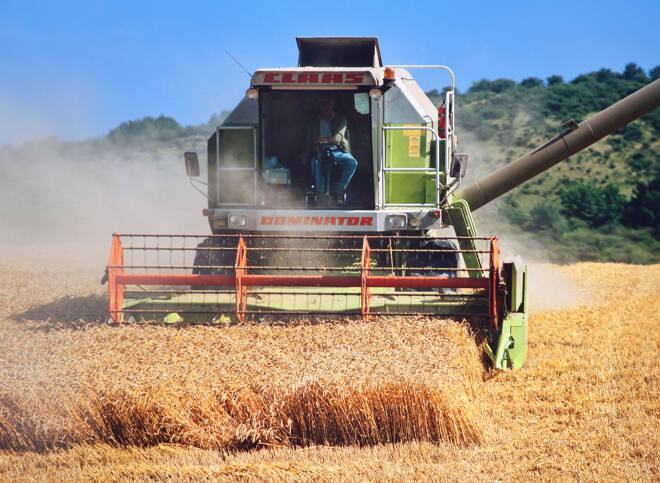Advertisement
Advertisement
Grains Forecast 2023 – US Prices Could Strengthen if Russia-Ukraine Conflict Leads to Supply Constrictions
By:
Volatility and supply concerns marked the U.S. agricultural markets in 2023, with all grains experiencing price fluctuations. The USDA's preliminary planting projections predict more wheat and corn planting but fewer soybean acres, while price ranges for all three grains have significant potential for both higher and lower prices due to various factors.
Volatility was the theme in the U.S. agricultural markets in 2023. Along with the annual seasonality, soybeans, corn and wheat were subject to huge swings early in the year after Russia invaded Ukraine.
Like all commodities in 2023, U.S. grains were also driven higher by soaring inflation, but those rallies failed once the Fed started raising rates in March and inflation subsided into the end of the year.
Prices also jumped on supply concerns following the Russian invasion of Ukraine. Wheat was especially vulnerable to a global shortage after Russia threatened to block supply from Ukraine from getting shipped.
Early USDA Planting Projections
The U.S. Department of Agriculture (USDA) in its preliminary baseline projections as of October forecast U.S. farmers will plant more wheat and corn in 2023 but fewer acres to soybeans.
What Will 2023 Projected Prices Be?
The year finished with soybeans and corn near their highs of the year and wheat prices at nearly breakeven. Without knowing how much farmers will plant, historical data is used to price futures forecasts. Once analysts know the amount of acreage to be planted, they can forecast more accurately where prices could be at the end of 2023.
Based on the ranges of historical price changes, University of Illinois analysts project:
- Soybean prices over $14 per bushel at 28%.
- Soybean prices between $13 and $14 per bushel at 48%.
- Soybean prices less than $13 per bushel at 24%.
Based on the ranges of historical price changes, University of Illinois analysts project:
- Corn prices over $6.65 per bushel at 28%.
- Corn prices between $5.65 and $6.65 per bushel at 62%
- Corn Prices less than $5.65 per bushel at 10%.
Wheat Prices Could Weaken
On December 1, Fitch Solutions’ wheat price forecast for 2023 expected the grain to trade around $8.6 per bushel in 2023, dropping from estimated $9.33 per bushel in 2022.
Early Strength, but Risks Exist
Once analysts know the acreage to be planted in 2023, they can make more delayed projections throughout the year by analyzing the pace of planting, the crops’ development and harvest expectations. Furthermore, more data will be available on major grain deals particularly with Europe due to concerns over shortages.
Additionally, farmers can establish price floors under revenue using crop insurance products. Prices at the end of 2022 point to relatively high projected prices, and expectations will center around $6.15 per bushel for corn and $13.45 per bushel for soybeans.
Still, historical price changes suggest that there are significant possibilities for lower projected prices. Lower price projections could occur because of a combination of the following factors:
- Brazil has a good planting season, plants a large crop, and prospects are for a good growing season.
- The Russia-Ukraine conflict becomes more settled, leading to more reliable supply from the Ukraine and Russia.
- The world economy heads into a recession, leading to a reduction in demand for agricultural goods.
But even higher prices are possible in 2023, likely due to the combination of these factors:
- The Ukraine-Russia conflict leads to further constrictions in supply.
- Brazil has a poor growing season.
Conclusion
As mentioned earlier, the price projections for 2023 at the end of 2022 are usually based on historical probabilities. This method assumes that today’s risks are similar to those of recent history.
However, one has to be concerned over the conflict with Ukraine-Russia. It could continue or it could escalate, driving up the risk of higher prices.
Additionally, the financial markets could be headed to turbulent times because of Fed rate hikes and the risk of a global recession.
Finally, the fear of the unknown risks will be a concern until at least the end of February when projected prices will be determined with more accuracy once the farmer planting intentions are known.
For a look at all of today’s economic events, check out our economic calendar.
About the Author
James Hyerczykauthor
James Hyerczyk is a U.S. based seasoned technical analyst and educator with over 40 years of experience in market analysis and trading, specializing in chart patterns and price movement. He is the author of two books on technical analysis and has a background in both futures and stock markets.
Advertisement
